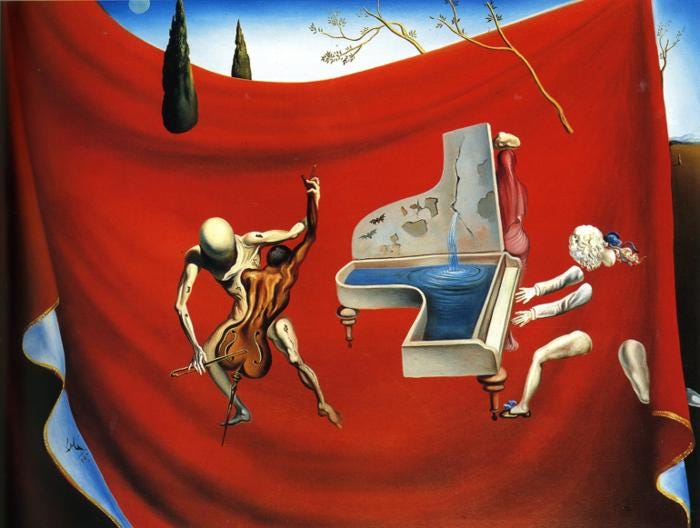 When Dalí, a connoisseur of the bizarre and sublime, compared the album “666” to La Sagrada Família, Antoni Gaudí’s unfinished masterpiece, it was a statement that begged for exploration. How could a progressive rock album evoke the same grandeur, complexity, and spiritual resonance as one of the most iconic architectural feats in history? The story behind “666” and its connection to Dalí’s declaration offers a fascinating glimpse into the intersections of music, art, and cultural ambition.
When Dalí, a connoisseur of the bizarre and sublime, compared the album “666” to La Sagrada Família, Antoni Gaudí’s unfinished masterpiece, it was a statement that begged for exploration. How could a progressive rock album evoke the same grandeur, complexity, and spiritual resonance as one of the most iconic architectural feats in history? The story behind “666” and its connection to Dalí’s declaration offers a fascinating glimpse into the intersections of music, art, and cultural ambition.
The Genesis of “666”
“666” is the brainchild of Aphrodite’s Child, a Greek progressive rock band formed in the late 1960s. The group—featuring members Vangelis Papathanassiou (later famous as the composer of “Chariots of Fire” and “Blade Runner”), Demis Roussos, and Loukas Sideras—was already known for its unique blend of rock, folk, and classical influences. However, “666,” released in 1972, marked a dramatic departure from their earlier works.
The double album, subtitled The Apocalypse of John, 13/18, is a sprawling concept piece inspired by the Book of Revelation. It’s a sonic odyssey that blends progressive rock, experimental sounds, and theatrical narration to create an otherworldly experience. From its haunting choral arrangements to its hypnotic rhythms, “666” defied genre conventions and pushed the boundaries of what an album could be.
Dalí’s Fascination with “666”
For Salvador Dalí, “666” was more than just an album; it was a work of art that transcended its medium. According to accounts, Dalí was struck by the album’s audacity and the way it mirrored the spiritual and architectural complexity of La Sagrada Família. Gaudí’s cathedral, still under construction to this day, is a synthesis of Gothic and Art Nouveau styles, characterized by intricate details, towering spires, and a sense of divine inspiration. Similarly, “666” is a labyrinthine journey through themes of apocalypse, rebirth, and human consciousness.
Dalí was known for his admiration of artists and works that challenged conventional boundaries. He once described Gaudí’s La Sagrada Família as the embodiment of divine geometry and surrealist principles. By likening “666” to this architectural marvel, Dalí elevated the album to the realm of timeless art, suggesting that its creators had tapped into something universal and profound.
Themes and Structure of “666”
The album’s structure mirrors the fragmented, mosaic-like construction of La Sagrada Família. Divided into multiple tracks that range from ethereal instrumentals to spoken-word passages, “666” is a kaleidoscope of sound and storytelling. The music incorporates a wide array of influences, including Greek folk music, jazz, and electronic experimentation, reflecting the diverse artistic currents of the early 1970s.
One of the standout tracks, “The Four Horsemen,” captures the apocalyptic tone of the album with its eerie melodies and poetic lyrics. The piece builds gradually, layering haunting vocals over a hypnotic rhythm that evokes a sense of impending doom. Another notable segment is “Infinity,” a provocative spoken-word performance that challenges listeners with its raw emotion and avant-garde approach.
These tracks, like the intricate details of Gaudí’s cathedral, invite repeated listening and interpretation. Just as visitors to La Sagrada Família find new details to marvel at with each visit, listeners to “666” uncover fresh layers of meaning with each playthrough.
The Controversy and Legacy
When “666” was released, it sparked controversy for its unorthodox content and themes. The album’s biblical references and experimental nature alienated some listeners while captivating others. Critics were divided, with some praising its ambition and others dismissing it as pretentious or inaccessible.
Despite the initial mixed reception, “666” has since gained recognition as a landmark in progressive rock and experimental music. Its influence can be seen in the works of artists who followed, from Pink Floyd’s conceptual albums to the electronic innovations of Vangelis’ solo career.
The album’s enduring appeal lies in its ability to challenge and inspire. Like La Sagrada Família, it stands as a testament to the power of human creativity and the pursuit of the sublime. Both works invite their audiences to think beyond the ordinary and to engage with the mysteries of existence.
Dalí, Gaudí, and the Artistic Legacy
Dalí’s comparison of “666” to La Sagrada Família underscores his belief in the interconnectedness of all art forms. For Dalí, the boundaries between music, architecture, painting, and literature were fluid, and great art transcended these distinctions. By aligning “666” with Gaudí’s masterpiece, he placed the album within a broader artistic tradition that values innovation, complexity, and spiritual exploration.
Both La Sagrada Família and “666” challenge the idea of completion. Gaudí’s cathedral remains unfinished, a perpetual work-in-progress that invites future generations to contribute to its vision. Similarly, “666” defies closure, leaving its themes open to interpretation and its sounds open to reinvention.
Conclusion
“666” is more than an album; it’s a journey into the depths of human imagination and a testament to the transformative power of art. Salvador Dalí’s endorsement of the album as the musical equivalent of La Sagrada Família adds a layer of mystique and significance to its legacy. Both works stand as monuments to the boundless possibilities of creativity, reminding us that art, in all its forms, has the power to elevate, challenge, and inspire.
For those who have yet to experience “666,” Dalí’s words offer an invitation: listen with an open mind and a willingness to explore. Like La Sagrada Família, the album is a masterpiece that rewards those who dare to engage with its complexities and embrace its vision. And for fans of both Dalí and Gaudí, it’s a chance to see how the threads of genius can weave together across different mediums and eras

Leave a Reply